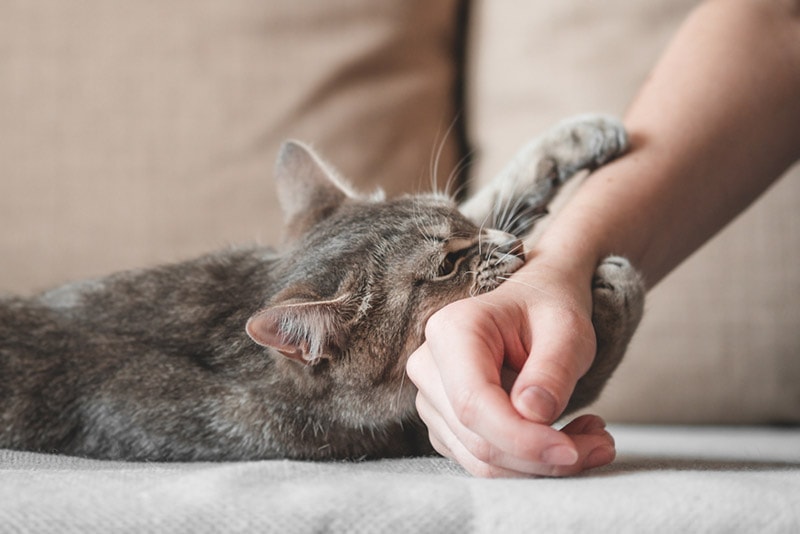Why Is My Kitten So Aggressive? 9 Reasons & How to Prevent It
Updated on

Click to Skip Ahead
Aggression in kittens is common and there are plenty of reasons for it. To properly address the problem, you should first identify the reason for the aggression. This may be easy for some. For example, if you’ve just brought your kitten home, they may be fearful of their new surroundings. However, not all aggression is so easy to determine.
Take a look at the nine most common reasons for aggression in kittens below to see if you can identify why your kitten is acting out. Then, keep reading for some tips to help prevent the behavior.
The 9 Reasons Why Kittens Get So Aggressive
1. Fear Aggression
Like most animals, cats will get defensive if threatened. The more threatened they feel, the more aggressive they will become. Many kittens will be fearful of a new environment, so it’s important to let them adjust to their new home and surroundings, especially other people and pets in the home. Fear aggression in kittens is often defensive, not offensive.
Look for signs that they are crouching, flattening the ears, and tucking the tail in order to appear small in addition to typical aggression signs.

2. Territorial Aggression
Although more common in sexually mature cats, kittens can become territorial once they get to know their new surroundings. They may decide to oust older cats, leading to spats between pets. Kittens that “get too big for their britches” and get territorial could claim a certain litter box as theirs, becoming aggressive should anyone come near it, or they could claim the entire home.
The important thing to note is that being territorial doesn’t have to lead to aggression and that behavior modification is necessary to curb any unwanted conduct.
3. Play Aggression
Play aggression is the most common behavior problem faced by new kitten owners. Many kittens learn to hold back their bites and claws when playing with their littermates. They will most likely have learned the difference between play and typical predatory behaviors like ambushing and pouncing. However, if they were separated from their litter or weaned from their mother very young, they may not have learned the difference.
When adopting a young kitten, setting clear boundaries regarding play and just how rough you will allow them to get is essential. Rough play may lead to worsening play aggression.

4. Petting Aggression
Every cat is unique with being petted and held. Some love the attention and will sit with you for hours while others refuse to be touched at all. Most cats fall somewhere in the middle. While you are learning your new kitten’s likes and dislikes, there is likely to be some petting aggression. This form of aggression occurs when you pet them in a way they don’t like, they let you know with a hiss, swat of their claws, or nip of teeth, and then run away from you.
Be sure to pay attention to their body language and learn what they enjoy, merely tolerate, and will not stand for when it comes to physical attention.
5. Redirected Aggression
This form of aggression is very common and is one of the more dangerous ones. You’re more likely to see it with indoor cats. When a cat is agitated by something they cannot react to directly, such as another cat outside they can’t reach, they will still want to respond to it. It may not be immediate, but they will likely lash out at someone else. These attacks can be unprovoked but are not malicious or intentional. Instead, they are automatic, as felines are a predatory species.
Kittens are especially prone to redirected aggression as they are more likely to be aroused by objects and situations outside of their domain, such as things seen outside of a window.

6. Predatory Aggression
Kittens may not understand the thin line between play and predatory behaviors. Because of this, they could end up stalking and pouncing on another pet in the home and hurting them instead of initiating play. This could, in turn, cause a defensive reaction from the other pet, resulting in a dangerous fight.
You may see predatory behaviors even in play, so it’s difficult to differentiate between play and aggression. However, if anyone should get hurt, it’s important to initiate behavior modification as soon as possible.
7. Sexual Aggression
Male kittens will probably exhibit more aggressive behaviors when they reach sexual maturity. The most common sign of this type of aggression is biting. Unlike other types of aggression that can be altered with behavioral training and environmental changes, this can only be prevented or stopped with neutering.
Neutering can also help to prevent unwanted litters if there is an unspayed female cat in the home or if your male cat were to get out of the house.

8. Pain & Sickness Aggression
While pain aggression is more common in older cats with arthritis and other chronic ailments, kittens are not immune to pain or illness. Like humans, our pets can become irritable when they are in pain or don’t feel well. Kittens are susceptible to many illnesses, especially before they’ve had all of their vaccinations, and their rough play sometimes makes it easy to get hurt.
If your kitten is normally very well-behaved and nothing in the home has changed that would explain their sudden aggression, it could be time to take them to the vet to make sure that they aren’t sick or injured.
9. Noise Aggression
All cats are susceptible to noise aggression. Like dogs, cats hear certain frequencies of sound differently than humans and may respond to them differently as well. They may not care for the sound of another cat wailing outside, or a baby crying in another room, especially if they aren’t able to check on the baby to make sure they are okay. Some kittens don’t like the sound of a dog’s squeaky toy.
If you notice your cat reacting violently to certain sounds, you may need to remove or minimize those sounds in the home.

Signs of an Aggressive Kitten
The first step in addressing aggressive cat behavior is recognizing it. Not all perceived aggressive behavior actually is. Playing roughly or being overstimulated by their surroundings may cause the behavior.
- Biting
- Scratching
- Hissing
- Marking
- Crouching
- Pinning their ears
- Arched back
- Twitching
 How to Prevent Aggression in Kittens
How to Prevent Aggression in Kittens
Besides the tips provided for each type of aggression listed above, here are some basic tips you can follow when addressing the problem. Remember to intervene as soon as possible to curb any unwanted behavior while they are still very young. Very young kittens are more likely to respond to behavior modification attempts.
Rule Out Medical Problems
The first step in preventing aggression in kittens is to rule out any underlying medical problem for the behavior. If they aren’t feeling well or are in pain, it could be causing them to lash out toward you or other pets in the home. Once their vet has given them a clean bill of health, it’s safe to assume that their behavior is caused by their environment and can be adjusted.

Avoid Physical Punishment
Physical punishment usually only results in worsening aggression, especially in kittens. It is usually seen as threatening, which naturally leads to defensive behavior. There are many other more effective ways you can help your kitten calm down without resorting to physical punishment.
Startle Them Without Contact
One way to immediately stop aggression in the moment is to startle them. A sudden, loud noise will usually work well. Try clapping your hands to redirect their attention. This won’t work if their aggression is caused by loud noises, so be sure to pay attention to your cat’s body language and learn from their reactions to your own behavior. If a loud noise doesn’t work or makes matters worse, you may try tossing something in their direction without making contact with them.
Avoid Triggering Situations
If you know that your kitten becomes agitated when watching someone mow the lawn from the living room window, try blocking their view of it to help avoid redirected aggression later. You can also avoid petting aggression by teaching others in the house what your pet likes and doesn’t like when it comes to giving attention. This is especially true for young children who may not understand a cat’s social cues.
Separate Aggressive Pets
When introducing a new kitten, you will need to separate them from other pets in the home at first. Introducing them slowly ensures they adjust to each other’s presence over time. Still, kittens can be rambunctious and other pets may need a break at times. If you notice one or more pets becoming aggressive, act quickly to separate them, giving each a break from the situation until they calm down.

Use Treats
Treats are an excellent motivator for cats. They can help encourage non-aggressive behavior, especially in kittens. Be sure to reward good behavior, especially when they are interacting with other pets and people in the home. ignoring the bad behavior and rewarding the good behavior will help to cement your expectations of them, especially when you start this very young.
Try Medications
If none of the above techniques are effective, or not effective enough, you may want to try calming medications. There are over-the-counter calming chews and treats that could help. You will need to speak with your veterinarian before resorting to medications, as they could have other solutions for you or recommend the best way to use them.
Meet With a Veterinary Behaviorist
Veterinary behaviorists are specialized in behavior modification for pets. They can help by suggesting techniques to alter your pet’s reactions to your own behavior. A behaviorist often visits your home to see how you and others interact with the pets so they can make the most effective recommendations. This is often the last step taken but can help many pet parents adjust to life with a new kitten who is acting aggressively.
Conclusion
If you think your kitten is acting aggressively, it’s important to first recognize the signs. Then, you should try to identify the reason for their aggression, as it may determine the best way to address the problem. From there, meet with their veterinarian to rule out medical causes for their behavior and be consistent in behavior modification to help calm them.
Aggression in kittens is common, but there are plenty of ways you can help address the problem.
Featured Image Credit: Sozina Kseniia, Shutterstock











